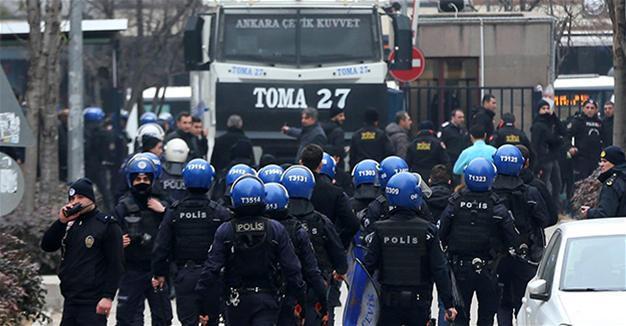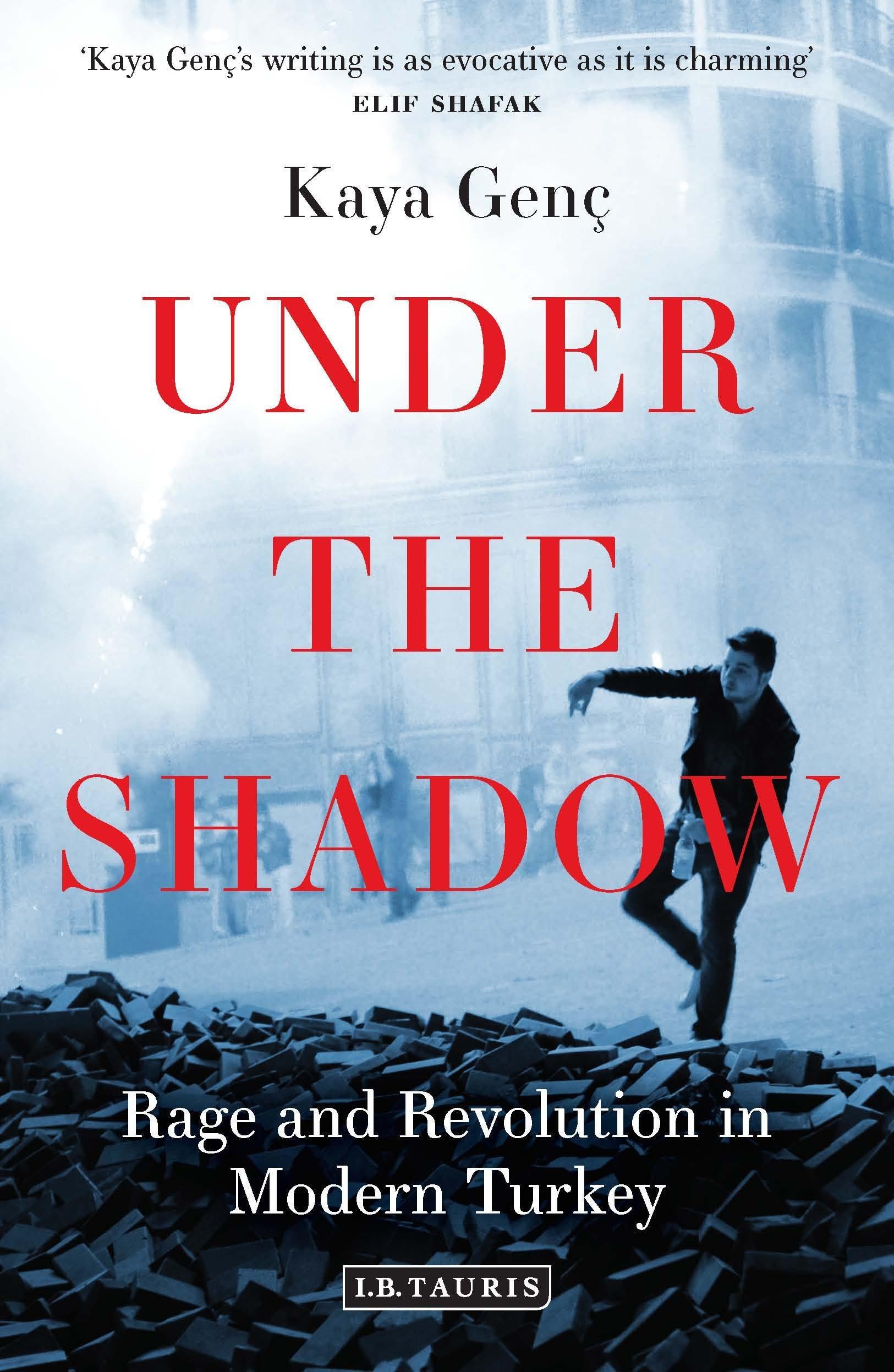Rage and revolution in modern Turkey
William Armstrong - william.armstrong@hdn.com.tr

Riot police stand at the entrance of Ankara University’s Cebeci campus during student protests against the dismissal of academics in a post-coup state of emergency decree in February 2017.
‘Under the Shadows: Rage and Revolution in Modern Turkey’ by Kaya Genç (IB Tauris, 224 pages, $15)Ahead of Turkey’s critical but unappetizing referendum on constitutional changes, there is demand abroad for accounts of the country that go beyond the typical headlines. Amid rising nationalist populism across the world, Turkey and its President Recep Tayyip Erdoğan draw attention as pioneers of a bellicose new political style spreading from Brexit Britain to Trump’s America to Marine Le Pen’s insurgency in France.
 “Under the Shadow: Rage and Revolution in Modern Turkey” by novelist Kaya Genç is another attempt to explain Turkey to an English-language audience. Compared to many passionately partisan accounts that have appeared in recent months, Genç takes an ostensibly more impartial stance. His book charts a modest but original course, giving voice to young actors across the political spectrum to paint a polyphonic portrait of contemporary Turkey.
“Under the Shadow: Rage and Revolution in Modern Turkey” by novelist Kaya Genç is another attempt to explain Turkey to an English-language audience. Compared to many passionately partisan accounts that have appeared in recent months, Genç takes an ostensibly more impartial stance. His book charts a modest but original course, giving voice to young actors across the political spectrum to paint a polyphonic portrait of contemporary Turkey. The mood darkened over the period when Genç was writing. He describes how Turkey went from being among the world’s top tourism destinations and a robust economy seemingly immune to the chaos over the border in Syria to hosting a new, “more ominous form of politics: the placing of bombs inside rubbish bins and news about foreign fighters wearing suicide belts walking into tourist groups to kill Europeans. The kidnapping of generals and the crackdown on military plotters.” Turkey has become “such a violent stage for political conflict that its elderly citizens point to the dark period of 1970s radicalism as a worrying example that parallels the present.”
Genç provides pen portraits of young Turks across the spectrum, “divided in politics but united in their passion.” The way to understand “angry young Turkey,” he writes, is not to look at one group of activists, “but to look at a much wider range that includes both the political movement represented by the current government and ones that show the most powerful resistance to it.” It is not only “young seculars” or “young leftists” or “young liberals” who are politicized in today’s Turkey, “‘conservatives’ who voted for the current government have similarly been defined by their frustration and discontent, which they have successfully transformed into a political organization.” Many of those profiled are searching around for an identity on which to pin themselves. One young adviser to the left-wing politician Sırrı Süreyya Önder remembers how he had earlier protested against the war in Iraq and atrocities in Bosnia and “wondered whether I should become an Islamist.”
Genç traces the current bitter divide to the 19th century, contrasting the “Young Turks” and the “Young Ottomans” in the twilight years of the Ottoman Empire: The latter were conservative reformers who looked to the empire’s Islamic heritage for inspiration; the former were more uncompromising Westernizing constitutionalists. Genç claims that contemporary Turkey’s civil society gathers its cultural and political energy from the antagonism between these century-old rivals. Despite analyses of unrest in Turkey describing it as a “fight between a monolithic group of young activists and a repressive system supported by ignorant masses who should know better, the real dynamic among Turkey’s furious youth exists between these equally influential and long-lasting historico-political positions,” he writes.
Encompassing such a broad spectrum is a good idea. But “Under the Shadow” contains some misrepresentations. Genç implies that the 1980 coup was primarily about reasserting secularism, despite the fact that it actually set Turkey on its current religious-nationalist path. He also makes the common mistake of claiming that Turkey’s GDP per capita has trebled since 2002, which is only true in nominal – not real – terms (in fact Turkey’s GDP has actually risen more slowly than that of most other emerging markets). He claims that “Westernization and bureaucracy” are the “two main antagonists of Turkey’s modern-day conservatives,” but in reality right-wing conservatives have for decades had a large say in shaping the Turkish state, and are quite happy with the bureaucracy when they are in charge.
Throughout the book one side is held to a higher standard than the other. Anti-govern¬ment voices are typically presented as fickle and reckless, punctuating their observations with exclamation marks. These secular “elites,” Genç writes, are marked by “alienation from other sectors of society” and live “in a bubble of privilege.” Genç describes the arts worker Lara Fresko as a “curly-haired and self-confident curator-cum-art-historian-cum-political-theory-enthusiast,” while the publisher Can Öz is a “rhetorician.” Those on the other side of the divide are implicitly portrayed as more level-headed (despite often being rigidly ideological).
In the book’s final section on “Turkey’s angry young entrepreneurs,” a secular-minded young Turk who inherited his father’s business is contrasted with a government-supporting supposed “self-made man” in the construction industry. The construction sector is among the jewels of Erdoğan’s “New Turkey” and Yavuz Fettahoğlu is a typical construction tycoon. But Genç never addresses the sector’s rampant corruption, its shady ties to state power, and the old-fashioned clientelism that have facilitated its expansion. What’s more, Fettahoğlu is not even a self-made man, having inherited his father’s 25-year-old firm.
Ultimately, “Under the Shadow” gives us a partial perspective. Viewing Turkey purely as a war between social tribes ignores the question of how power is exercised, who currently holds it, and the grave results of its misuse. Turkey certainly does have an angry, energized public space with many different voices, but one side clearly holds the whip hand at present. Genç should be applauded for giving a more multifarious portrait than many, but Turkey cannot be understood simply as a case of warring social tribes.
* A version of this review was first published by the Times Literary Supplement. Follow the Turkey Book Talk podcast via Twitter, iTunes, Stitcher, Podbean, Acast, or Facebook.










